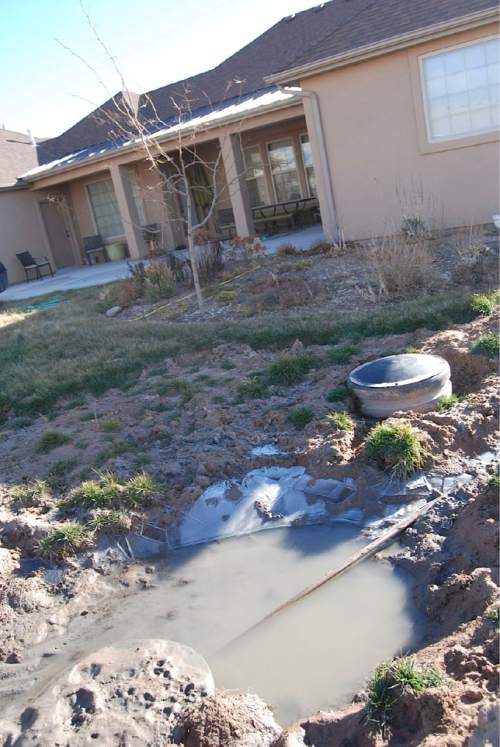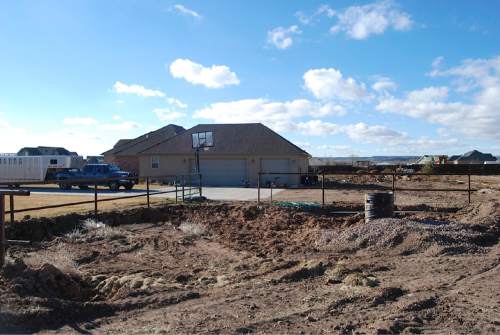This is an archived article that was published on sltrib.com in 2014, and information in the article may be outdated. It is provided only for personal research purposes and may not be reprinted.
Roosevelt • The Stonegate subdivision seems like a great place to settle down and raise kids. But a dank secret lurks under its sprawling lawns.
Just 2 miles west of Roosevelt's downtown, the neighborhood is insulated from the industrial traffic and oil field service companies that clog an energy boomtown in the heart of the Uinta Basin. Large stucco, log and stone homes dot the landscape — 4,000 square feet of the American dream nestled on 1-acre lots carved out along rows of cul-de-sacs. Alfalfa fields and wetlands spread in three directions. To the north, panoramic vistas of the High Uintas rise up unbroken.
But there's one big hitch.
When you flush the toilet here, the effluent is liable to end up in your basement. Or in Dan Robinson's yard, which he has torn up in an expensive but failed bid to salvage his septic system in the face of a rising water table.
Now, Robinson's 5-year-old home is surrounded with what he calls "an open sewer," a mud bog saturated with his neighbors' sewage.
"We have invested a lot in our homes and now, because state law wasn't followed, we don't have homes that can be lived in," said Robinson, a dentist. "Everyone is affected. No one can sell [his] home and move."
The Robinson family has abandoned their home. Other homeowners run sump pumps all day to keep the rising water table out of their crumbling basements. And local officials are scrambling for a solution, which will require establishing a special sewer district and an expensive bailout, possibly from the state.
Robinson and other homeowners believe all of it could have been avoided if local government leaders had reviewed the history and geology of the land and been able to tell a developer "no."
—
Soggy foundations of a crisis • This boggy field outside Roosevelt lay undeveloped for generations. With a water table so high tractors sank in the muck, even local farmers didn't attempt to tame it.
Eventually, even Roosevelt had to grow, spurred by oil and gas development workers looking for homes and retirees intent on buying big homes near the grandkids.
In 2002, developer Bob West started consolidating property in the area, buying 320 acres from longtime owner Earl Christensen. Eventually, West's firm, RS West Enterprises, won permission to subdivide 80 acres, carving up one-acre lots in three phases at Hancock Cove (named for the area's first European settler, Ether Hancock) and selling them for $40,000 each.
In all, Hancock Cove subdivisions are platted for 700 lots; 300 of them have homes on them.
West's development seems to have accelerated a troubling geologic phenomenon: As development has spread onto agricultural lands, the water table has risen, pushing wastewater out of septic systems, saturating yards, cracking foundations and contaminating surface water with E. coli bacteria.
The situation has become so severe that Duchesne County and the local health department last week imposed a building moratorium until the area can be piped for a sewer.
Irrigation from farms and yards, stormwater from last fall's rains and an increasing number of septic systems in what is still a rural neighborhood have combined to create a noxious, subsurface soup. Underneath it all, a layer of confining bedrock blocks drainage.
"It's a bathtub-type situation. Once the bathtub fills, it seeps out very slowly," said Scott Hacking, a district engineer with the Utah Department of Environmental Quality. "It has all reached critical mass and the Robinson property is ground zero — the shallowest place where the problems are manifesting."
Robinson and other neighbors contend Duchesne County should not have authorized West's project without first draining the land.
"They bought swampy agricultural land cheap and turned it into expensive homes," said Stonegate resident Andy Adamson, whose foundation and septic system are failing. "They approved things they should not have and now we are paying for it."
West did not return a message left at his Roosevelt office.
At various public meetings in recent weeks, the developer has steadfastly argued his land was suitable for septic systems when he started subdividing a decade ago and factors beyond his control have affected the water table.
The TriCounty Health Department, the agency that approved Stonegate for septic systems in the first place, backs up West's explanation.
"I don't know how you would anticipate it. There was nothing in the monitoring that indicated that we could not approve on-site wastewater systems," said Darrin Brown, TriCounty's environmental health director. "Most of the monitoring showed [the water table] was five or six feet down."
The agency monitored Stonegate's water table for a year before signing off on the phase-one plats in 2005.
Four inches of rain fell on Roosevelt in August and September, months that combine on average for about 1.6 inches of precipitation, Health Department director Jordan Mathis said.
That extra rain, along with homeowners zealously watering their landscaping and neighboring farmers irrigating their fields have combined to raise the water table.
"All these things may be coming together, creating this issue we face now," Mathis said. "There was nothing in the rules that would disallow a subdivision there."
But Robinson, who has moved his wife and their six children to in-laws' homes on the Wasatch Front, remains skeptical. He and other critics say the region's drainage problems were well-documented a decade ago, and the health department should have anticipated the growing water use.
—
Shifting water and blame • Robinson's septic nightmare started long before those August monsoons.
The water table at his property has hovered between 10 and 22 inches since the summer. He has dug three wells in his yard, which remains a smelly bog even though he moved his family out six months ago.
Under state law, septic systems cannot be approved unless the maximum water table is at least 34 inches below the ground's surface.
"There is not a single septic system that is functioning correctly," said Robinson, a former professional football quarterback whose career diverted into dentistry after shoulder injuries.
In normal septic systems, household waste drains into an underground, 1,000-gallon tank. Solids settle at the bottom where microbes digest them. The remaining water drains in a system of pipes around a leach field. The engineering works only if the surrounding soil is porous and dry.
TriCounty Health Department is responsible for inspecting rural subdivisions and certifying that their lots can handle on-site wastewater treatment.
Critics of Stonegate's approvals say they were based on questionable percolation tests, some conducted in the dead of winter, when the ground is frozen. They also contend a maximum water table was not properly established as required under state law.
Stonegate's developer says he did everything the county and its health department required of him. Duchesne County officials say the health department was responsible for certifying subdivisions' suitability for septic. Health department leaders say they made their decisions based on the best information available at the time.
State regulations ban septic systems in places where the water table is too close to the surface, but they also instruct officials to consider rising tables.
Health department inspectors most recently certified Stonegate's third phase on July 1, a time when the water table crisis was already glaringly obvious to Robinson and his neighbors.
Robinson believes federal maps indicate the subdivision's third phase sits on wetlands.
During his first week on the job a few months after that approval, Mathis visited the mud hole behind Robinson's home. Within days, the department rescinded its approval for Stonegate's final phase, citing high ground water.
The septic problems are not confined to Stonegate. High water also is disrupting systems in other subdivisions with much larger lot sizes.
On Dec. 22, the TriCounty Health Department announced future development in a 6-square-mile section of the cove is no longer feasible.
Similar problems have arisen in Summit, Wasatch and other rural counties under development pressure, according to Cameron Mitchell, executive director of the Utah Association of Local Health Departments. Agencies must be careful to respect property rights while protecting public health, Mitchell says.
"You do the best you can with the data you have," he said. "You try to follow the rules but you can't second guess Mother Nature. There will be circumstances when water flows change."
Duchesne County leaders now believe the only permanent fix for Hancock Cove's septic woes is a sewer system. A recent engineering study concluded it will cost at least $7 million to tie this unincorporated area into Roosevelt's wastewater treatment system.
But first, the Stonegate must be drained to lower the water table — at a cost of about $1 million.
—
Homeowners on the hook • Meanwhile, property owners are struggling to keep their homes habitable.
Andy Adamson's foundation is deteriorating from groundwater rising through the cracks. He keeps two sumps pumping all the time to keep the basement dry. But he fears it is only a matter of time before the foundation and his septic system fail.
His problems began after the West family cleared 80 acres to the west of Stonegate and started irrigating the land for hay. Adamson says runoff escapes onto his lot, but Bob West's son Jared, who happened to be the builder who put up the Adamson home, kept irrigating to keep the field green.
To reduce the flow into the subdivision, the Wests dug a trench along the edge of the field abutting the lots. It captures some of the water, but residents say the berm and trench are both unsightly and unsafe.
"No one is taking responsibility and [homeowners] are holding the bag," Robinson said. "Unless a sewer goes in, it's not feasible to move back into my home. Even if you drain the land you have just put a Band-aid on it.
"My neighborhood has some of the nicest people you could possibly find," he added. "What is sad is they were really taken advantage of."















